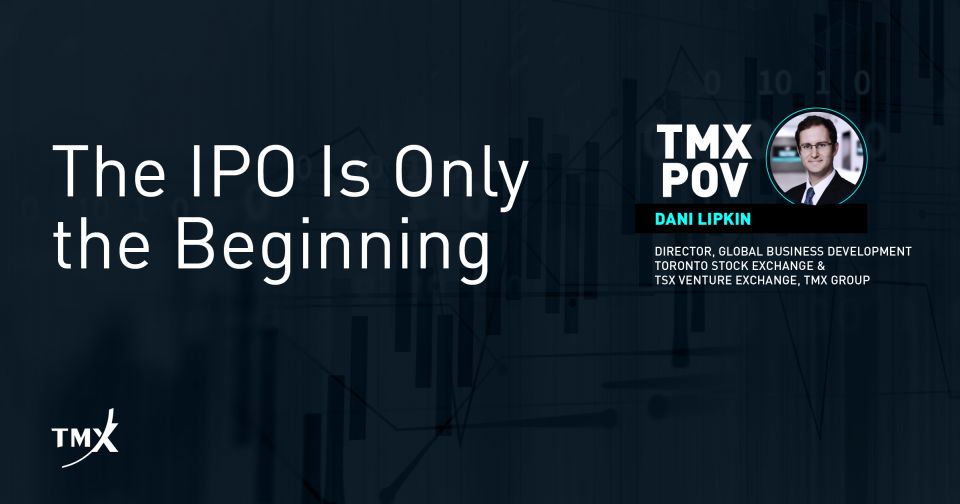TMX POV - It is just the beginning…

Did you know 2021 was a banner year for the tech sector in Canada? IPOs, new companies listing and financing activity records were shattered. Capital raised in the public markets for innovation companies has already eclipsed the previous annual record from 2020. Venture capital raised in the first six months of the year overtook all full-year records tracked by Canadian Venture Capital and Private Equity Association (CVCA). More Canadian tech companies are going public than ever before. It is a shining moment for the tech ecosystem and all of the efforts that have gone into creating a meaningful innovation economy.
And yet, when you hear buzz around the sector, like, "IPO size slashed", "unrealistic expectations", "IPO fails to ignite", you wonder if they're referring to the same capital raising market we are. This is the one of the greatest periods ever for tech companies on the public markets in Canada. Period. Yet, in some cases it has been treated like a failure.
Raising $10M, let alone $100M, is a notable accomplishment for any company. So when a company goes out and raises $100M as part of an IPO, it should be celebrated as a monumental milestone.
Through November 12, Toronto Stock Exchange (TSX) has seen 24 innovation sector companies go public through an IPO (and 74 new innovation listings in total). These are 24 companies that have piqued investor interest. For these companies, the IPO is not the end of the road but the continuation of their journey as a company. It is a way to help them in their next stage of growth, help accelerate their strategy, provide them with more capital for potential acquisitions, and help them receive publicity through their public listings. Companies go public with the long-term viewpoint that being public will help them grow into category leaders and create multi-generational companies. The IPO is just the beginning.
When you look at financing statistics for innovation companies listed on TSX and TSX Venture Exchange, the vast majority of financing comes from follow-on financings, not IPO proceeds. Of the $19.8B raised by innovation companies through the first ten months of 2021, only 26% of the total amount is attributed to going-public activity. The initial capital raised by companies going public is just the beginning of companies tapping the public markets for capital.
When these 24 companies started trading on TSX, many focused on the stock performance during the first days of trading. Evaluating the success or failure of an IPO based on how the stock trades in the first few weeks is not an indicator of future performance. Like any stock traded on a public market, you cannot evaluate its performance over the short term. Companies that perform well in the long term, and execute on their business plans, are rewarded in the long term with strong share price performance. If you want to gauge the success of tech companies over the long term, then it's better to look at the performance of the S&P/TSX Capped Information Technology Index* (TR) since this tracks 24 companies classified as information technology companies that are in the S&P/TSX Composite Index* - over the last 10 years it has had an annualized return of 24.4% (through October 29, 2021). The first few days of trading are just the beginning of a hopefully long and successful return for IPO investors.
When an IPO is priced, the share price must be balanced with the capital that the business will take in to run the business to expand sales and complete acquisitions. In our view, accurately pricing an IPO is a good thing and allows the company to attract long term investors.
So, let's not gauge any success or failure of an IPO by what happens immediately following on the first day of trading. Let's celebrate the amazing companies that have gotten to the point where they could go public. It is not an easy accomplishment, and we should recognize the huge success of the entire innovation ecosystem in helping to get these companies to the point of being able to IPO.
Dani Lipkin
Innovation Sector HeadToronto Stock Exchange & TSX Venture Exchange
Follow Dani on LinkedIn
© 2021, TSX Inc. Tous droits réservés. Il est interdit de copier, de distribuer, de vendre ou de modifier le présent article sans obtenir le consentement écrit préalable de TSX Inc. Les présents renseignements sont fournis à titre d’information seulement. Ni Groupe TMX Limitée ni ses sociétés affiliées ne garantissent l’exhaustivité des renseignements qui figurent dans le présent article et ne sont responsables des erreurs ou des omissions que ceux-ci pourraient comporter ni de l’utilisation qui pourrait en être faite. Le présent article ne vise pas à offrir des conseils en placement, en comptabilité ou en fiscalité ni des conseils juridiques, financiers ou autres, et l’on ne doit pas s’en remettre à celui-ci pour de tels conseils. L’information présentée ne vise pas à encourager l’achat de titres inscrits à la Bourse de Toronto ou à la Bourse de croissance TSX. Le Groupe TMX et ses sociétés affiliées ne cautionnent ni ne recommandent les titres mentionnés dans le présent article. The Future is Yours to See., TMX, le logo de TMX, Toronto Stock Exchange, TSX, TSX Venture Exchange, TSXV et Voir le futur. Réaliser l’avenir. sont les marques déposées de TSX Inc.
* L’Indice plafonné des technologies de l’information S&P/TSX et l’Indice composé S&P/TSX (les « indices ») sont des produits de S&P Dow Jones Indices LLC, ou de ses sociétés affiliées (« SPDJI »), et de TSX Inc. (« TSX »). Standard & Poor’sMD et S&PMD sont des marques déposées de Standard & Poor’s Financial Services LLC (« S&P »); Dow JonesMD est une marque déposée de Dow Jones Trademark Holdings LLC (« Dow Jones »); TSXMD est une marque déposée de TSX. SPDJI, Dow Jones, S&P, leurs sociétés affiliées respectives, et la TSX ne soutiennent, ne cautionnent, ne vendent, ni ne promeuvent aucun produit fondé sur les indices, ne font aucune déclaration quant au bien-fondé d’un placement dans un tel produit et ne peuvent être tenues responsables d’erreurs, d’omissions ou d’interruptions touchant les indices ou les données y afférentes.


